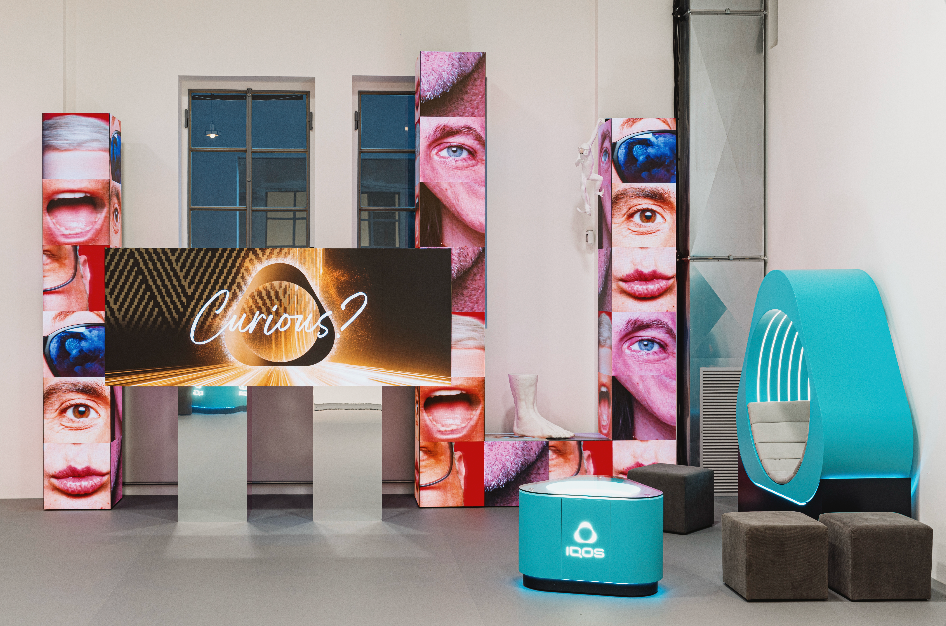Philip Morris and Italian designer Stefano Seletti team up for a curiosity-driven installation that reimagines the public square—and the future of tobacco
MILAN—At Milan Design Week 2025, Philip Morris International’s IQOS made its presence felt once again—not through a new device or product launch, but with an art installation.
This year’s exhibit, dubbed Curious X: Sensorium Piazza, is a sensory space meant to reimagine the Italian public square—traditionally a place of gathering, now a branded experience that mixes digital art, design, and corporate messaging.


The company partnered with Italian design brand Seletti to create the installation, part of a broader campaign called “IQOS Curious X.” The idea, according to PMI executives, is to explore how curiosity—framed here as a force for transformation—can redefine how people engage with spaces, objects, and, ultimately, tobacco.
PMI’s goal is clear: maintain IQOS’ visibility while positioning it as a forward-thinking, lifestyle-driven alternative to cigarettes. But the question remains—can design and aesthetics shift public perception of a tobacco company, especially one still facing regulatory scrutiny in many parts of the world?
Pasquale Frega, president of Philip Morris Italy, says the installation is a symbol of the brand’s evolution.
“We are here not only to present this beautiful space,” he said during the panel discussion, “but to highlight the progress toward a smoke-free future.”

The collaboration is steeped in symbolism. The Italian piazza is meant to evoke conversation and connection—values PMI hopes to associate with IQOS. Stefano Seletti, the designer behind the project, described the square as “a living archive of human connections,” though it’s worth noting that the installation is curated entirely within the context of a corporate campaign.
“We created something distinct,” Seletti told Manila Standard Life. “This collaboration mattered to me—it pushed my growth, and I hope I was able to contribute my perspective to their concept.”
“As an Italian, the concept of ‘piazza’ holds a special place in my heart and in our culture: it is the pulsating engine of our community. It is where we gather to celebrate, socialize, and simply enjoy the beauty of everyday life. It is a symbol of our shared identity,” he said.

Seletti’s CEO and creative director believes Milan Design Week is the ideal platform to explore design’s broader role in society. For him, innovation thrives not in isolation, but through constant exchange and the courage to compare, challenge, and evolve. He views this openness to dialogue as essential—not only for brands like IQOS, with whom this installation was created, but for the design community at large.
“I believe that Milan Design Week represents the perfect stage to tell the story of visionaries and the most innovative brands, just like IQOS. It is not always easy to compare oneself with other brands because sometimes this means questioning oneself, and not everyone is ready to do so,” Seletti said.
Seletti sees design not merely as an aesthetic exercise but as a force that shapes how we live and connect. Milan Design Week, then, is not just an event—it’s a space for transformation, collaboration, and meaningful cultural impact.
“We thought curiosity and innovation change the view of people on how they perceive nicotine to improve public health. Seletti changes the way we use things that we use in our daily lives, redesigning them in a completely unprecedented way. He steps out of the box, and by doing that, he brings a different level of sensorial experience—convincing people to change—and that’s what we have in common,” said Tommaso di Giovanni, PMI’s VP for Communications and Engagement.
PMI’s vision of a smoke-free future
PMI’s strategy relies heavily on the language of transformation. IQOS, which heats rather than burns tobacco, now claims over 32 million adult users worldwide. The company has consistently pushed the narrative that it offers a better alternative to smoking, even as regulators and public health experts continue to debate its long-term impact.


The art-driven campaign feels like an attempt to shift focus—from tobacco to technology, from smoking to curiosity, from health concerns to “sensorial” experiences. That’s not uncommon in the design world, where aesthetics often takes precedence over ethics. But it also signals how companies with contentious histories are increasingly relying on design to shape their public image.
“Today we have talked a lot about innovation, but I think it is important to also dwell on the concept of curiosity, because it is curiosity that drives us to challenge the status quo as we know it and to continuously improve,” said Stefano Volpetti, PMI’s President of Smoke-Free Products and Chief Consumer Officer.
“In our case, it was curiosity that guided the development of combustion-free alternatives like IQOS, different from traditional smoking products,” Volpetti said. “The Curious X campaign stems from this same spirit—the desire to overcome limits and explore new experiences. The collaboration with Seletti shows how curiosity can spark new ideas through unconventional design, as seen in the IQOS installation. Sensorium Piazza marks the first act of this year-long collaboration.”
“Lastly, what would a collaboration with a leading design mastermind like Seletti be, without some sort of innovative product design? Later this year we will be launching a very special limited-edition IQOS ILUMA device—designed by Stefano Seletti himself… first in Japan, followed by the rest of the world.”


As PMI expands its Curious X campaign globally, with similar installations planned in 20 countries and a limited-edition device designed by Seletti on the way, the company is betting that curiosity will do more than drive design—it will drive consumer behavior.
“In the coming years, we’ll be collaborating with more international artists and designers like Seletti, who push the boundaries of curiosity, creativity, and innovation so we can turn something of common use into something better,” said Giovanni.
Whether that bet pays off may depend less on artistic collaborations and more on how governments, consumers, and public health advocates respond to the idea of a “better” tobacco future packaged in gold sculptures and digital skies.








